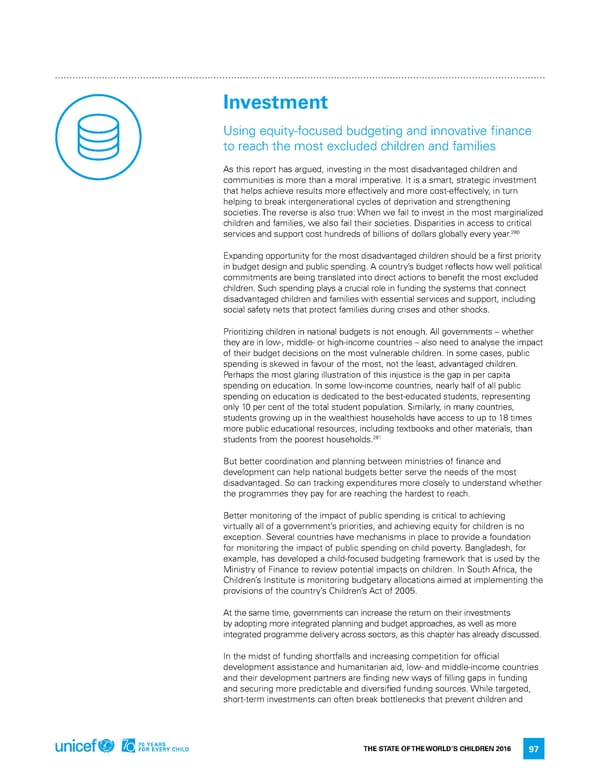Investment Using equity-focused budgeting and innovative finance to reach the most excluded children and families as this report has argued, investing in the most disadvantaged children and communities is more than a moral imperative. it is a smart, strategic investment that helps achieve results more effectively and more cost-effectively, in turn helping to break intergenerational cycles of deprivation and strengthening societies. The reverse is also true: When we fail to invest in the most marginalized children and families, we also fail their societies. disparities in access to critical 280 services and support cost hundreds of billions of dollars globally every year. expanding opportunity for the most disadvantaged children should be a first priority in budget design and public spending. a country’s budget reflects how well political commitments are being translated into direct actions to benefit the most excluded children. Such spending plays a crucial role in funding the systems that connect disadvantaged children and families with essential services and support, including social safety nets that protect families during crises and other shocks. Prioritizing children in national budgets is not enough. all governments – whether they are in low-, middle- or high-income countries – also need to analyse the impact of their budget decisions on the most vulnerable children. in some cases, public spending is skewed in favour of the most, not the least, advantaged children. Perhaps the most glaring illustration of this injustice is the gap in per capita spending on education. in some low-income countries, nearly half of all public spending on education is dedicated to the best-educated students, representing only 10 per cent of the total student population. Similarly, in many countries, students growing up in the wealthiest households have access to up to 18 times more public educational resources, including textbooks and other materials, than 281 students from the poorest households. But better coordination and planning between ministries of finance and development can help national budgets better serve the needs of the most disadvantaged. So can tracking expenditures more closely to understand whether the programmes they pay for are reaching the hardest to reach. Better monitoring of the impact of public spending is critical to achieving virtually all of a government’s priorities, and achieving equity for children is no exception. Several countries have mechanisms in place to provide a foundation for monitoring the impact of public spending on child poverty. Bangladesh, for example, has developed a child-focused budgeting framework that is used by the Ministry of finance to review potential impacts on children. in South africa, the Children’s institute is monitoring budgetary allocations aimed at implementing the provisions of the country’s Children’s act of 2005. at the same time, governments can increase the return on their investments by adopting more integrated planning and budget approaches, as well as more integrated programme delivery across sectors, as this chapter has already discussed. in the midst of funding shortfalls and increasing competition for official development assistance and humanitarian aid, low- and middle-income countries and their development partners are finding new ways of filling gaps in funding and securing more predictable and diversified funding sources. While targeted, short-term investments can often break bottlenecks that prevent children and The STaTe of The World’S Children 2016 97
 70 Years for Every Child Page 114 Page 116
70 Years for Every Child Page 114 Page 116